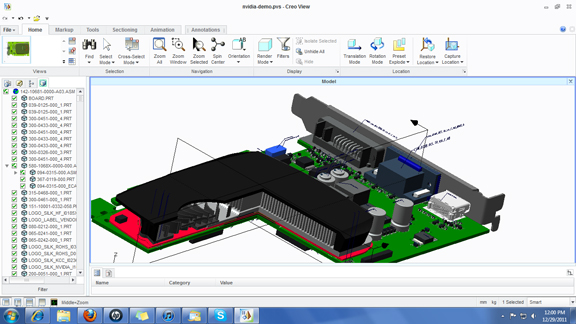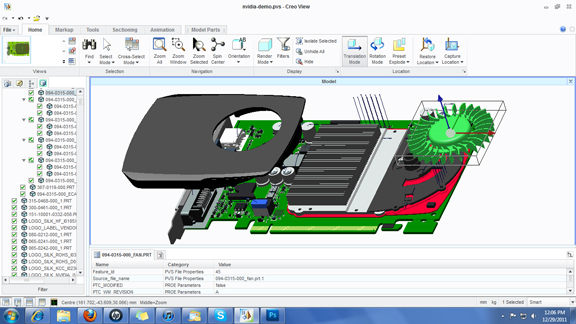December 29, 2011
PTC Creo View, part of the company’s ambitious Creo 1.0 app collection, was formerly known as PTC ProductView. It’s a lightweight standalone viewer, a program that lets you view, annotate, markup, share, and animate 3D CAD design files without a CAD program. Creo View contains Creo View Lite, Creo View MCAD, Creo View ECAD, and Creo View MCAD-ECAD (ideal for designs involving both mechanical and electrical components).
At initial launch, you’ll be prompted to pick which mode you’d like to work in (Lite, MCAD, ECAD, or MCAD-ECAD), along with the option to launch in a certain mode by default for subsequent sessions. This is also the chance for you to get rid of the start-up dialog box. I find that the start-up prompt, though less than ideal, is easier to deal with than looking for the option to switch mode midstream later (say, move from Lite to MCAD mode). So unless you know you’ll consistently be working with MCAD or ECAD, I’d advise against disabling this start-up prompt.
Creo View uses a native file format, along with several neutral 3D formats (IGES, STEP, VRML, and STL among them) and graphics formats (JPEG, TIFF). Keep in mind that, if you choose to work in Lite mode, you’ll be limited to fewer options. Assemblies load and respond to rotation commands fairly quickly, making the viewer a better alternative for inspecting, annotating, and animation 3D design files if you don’t plan to edit geometry.
Along with normal inspection tools (zoom, pan, rotate), you also get cross-sectioning tools and animation tools (Translate to drag and reposition components manually; explode to automate the process). Cross-sectioning command lets you drag a plane along an axis to reveal the inside of your assembly design. (You need to drag and cutting plane, not the arrow. The arrow is a direction indicator, not a drag-handle, as I quickly discovered.) Creo View gives you the option to perform quarter cuts, by using a combination of two cutting planes.
There are also Design Check and Interference Check commands for quick QA, along with measuring tools to double-check distances between edges and components. The structural tree and the option to launch a component as a new view gives you option to drill down to specific parts you’d like to inspect or discuss in your annotations. If your assembly has substructures with proper hierarchy, you can automatically generate a BOM.
As a viewer, Creo View works as you’d expect. A greater advantage of Creo View may be its integration with Windchill, PTC’s data management program. Such a setup, according to PTC, will help you manage your comments, annotations, discussions, and related source files in an organized fashion with a digital paper trail. (This is a feature I cannot test, as I don’t work within an enterprise data-management environment.)
Creo 1.0’s installation process, however, can use a few improvements. Even with PTC tech support’s willing assistance, installing Creo View and Creo Direct (I’ll be reviewing it early next year) took me a few sessions. One possible source of the problem: The company’s Flex licensing is aimed at enterprise installation, so installation for individual machine (node-locked mode) becomes unnecessarily complex. PTC revealed it’s working on improving the installation process for subsequent updates.
For more, watch the video report below:
Subscribe to our FREE magazine, FREE email newsletters or both!
About the Author
Kenneth Wong is Digital Engineering’s resident blogger and senior editor. Email him at [email protected] or share your thoughts on this article at digitaleng.news/facebook.
Follow DERelated Topics








